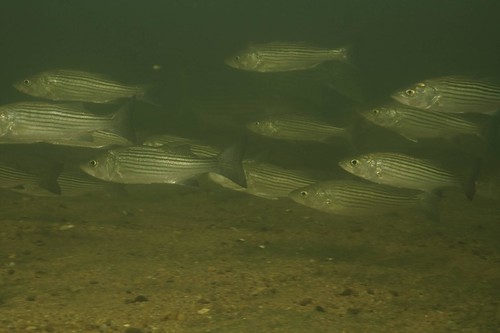Maryland Fishing Report: July 11
If you spend enough time hanging around seasoned commercial or sport fishermen, you’ll often hear that it’s impossible to figure out why finfish and blue crabs are in certain places at certain times.
These thoughts came to mind this week as I spoke to some of the most respected captains on the Chesapeake about how this season’s fishing is shaping up. There is not enough space to share all of the classic statements, but many captains repeated the two that I have heard throughout my life on the water: “No two years are the same,” and “Just when you think you have them figured out, they make a fool of you.”
The use of circle hooks when chumming for striped bass is slowly gaining acceptance, but we understand it’s not an easy transition for many, due to the instinct of trying to set the hook when a fish picks up a bait.
Studies at the Oxford Lab in the 1990s showed that circle hooks in the 9/0, 10/0 size range gave the best results in preventing deep hooking of 17 to 20-inch striped bass. Deep hooking did occur with circle hooks in the 4/0, 6/0 size range. Also there are a lot of different circle hook designs out there and some of them tend to look like a hybrid. The point of the hook should be pointing perpendicular to the shank of the hook.
One last item is that many captains have learned to snell their circle hooks to the leader to ensure a straight pull, which seems to help a lot with the hook engaging the side of the mouth properly. Anglers will also learn the best ways of placing the circle hook in a bait by experience, and when live lining always remember when a fish is swallowing a prey fish they swallow it head first, so try hooking your live bait more toward the tail end.
Weekly Fishing Conditions Forecast Summary: July 11-17
As the summer progresses, water conditions are forcing rockfish into smaller and smaller areas. With the water moving closer to temperatures rockfish will avoid – below 84 degrees – anglers should stick to the main stem. Seek out the coolest water with adequate oxygen available that combines excellent structure, moving water and bait. Focus your fishing times to low light periods when nighttime temperatures provide limited relief for hungry gamefish.
Expect the continued hot, sunny weather to continue to push water temperatures toward the mid-80s. Besides some possible rain Tuesday, anglers will experience typical fishing conditions for most of the upcoming week. Warmer temperatures will result in rockfish seeking cooler, deeper waters with adequate oxygen. However, other portions of the main bay and tidal rivers have much better oxygen conditions so be sure to check the full forecast and the Don’t Fish Below this Depth for conditions in your area.
There will be above average tidal currents all week as a result of the upcoming new moon July 13.
For the weekly fishing conditions summary, please be sure to check out Click Before You Cast.
Upper Chesapeake Bay
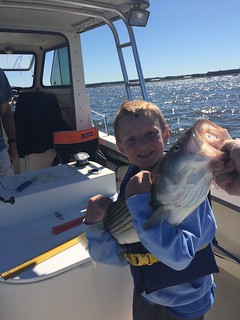
Johnny Andryszak got to go chumming with his dad and grandfather and had fun catching striped bass north of Rock Hall. Photo by Nick Andryszak
The chumming fleets have been following the northward movement of striped bass that have now left traditional locations that were so productive only a week or so ago. We are now talking about shoal areas in the Tolchester/Pooles Island region. These shoal areas with names like the Lumps, Gales Lumps, Pooles Island Lumps, Coal Lumps, Tolchester and Mitchells Bluffs are locations where chumming is taking place. The fishing has been very good with the usual high number of throwbacks but a steady number of legal-sized striped bass. Baits allowed to drift to the bottom of a chum slick will also attract the attention of channel catfish.
Striped bass are seeking out oxygen-rich water and cooler temperatures. Temperatures are near 82 degrees and only getting warmer. These are very stressful conditions for striped bass and care should be taken when unhooking sublegal-sized fish. If possible they should be unhooked in the water, and there is no tool better than a pair of needle-nose pliers to rotate the circle hook out of the corner of the fish’s mouth. Damaging the slime layer on the fish by handling will increase the chances of skin lesions or sores and hot air temperatures can damage gill surfaces.
Boats have been anchoring up near the Bay Bridge piers on the eastern side along the 16 to 25-foot edge, and chumming with good results. The sewer pipe has also been getting the attention of those chumming. On the western side of the bridge, fishing for white perch in the shallower waters has been good. The Francis Scott Key Bridge piers have also been a good place to chum for striped bass and others are live lining eels with good results. Trolling can be a good option at the mouths of some of the major tidal rivers such as the Patapsco. Red and green hoses, as well as gold spoons pulled behind inline weights have been good choices.
Striped bass fishing in continues to be overshadowed by the chumming action in the upper bay. There are some prospects though at Thomas Point and a few locations in Eastern Bay. There has been some early morning chumming action in Eastern Bay at Hollicutts Noose, Wades Point and Tilghman Point. The action tends to be a morning affair and quickly tapers off as the sun rises higher in the sky. Slowly surveying the bottom for suspended fish with a depth finder before starting a chum slick is essential. Spot can be found in the lower Choptank River, Eastern Bay and off Chesapeake Beach. Live lining along channel edges wherever suspended striped bass can be found is a very good option.
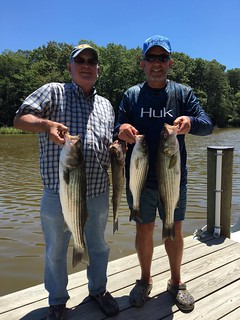
Herb Floyd and Jimmy Sargent managed to roll out of bed early enough to enjoy some early morning shallow water striped bass fishing in the lower Choptank yesterday. Photo courtesy of Herb Floyd
The early morning shallow-water fishery offers one of the best and most exciting ways to fish with light tackle for striped bass. Many shoreline structure areas and prominent points are great places to cast topwater lures. There are a lot of sublegal fish, but often plenty of action and a few legal fish to take home if you care.
Kent Narrows has been a good place to drift cut baits, live eels, live white perch, spot or casting swimshads, whether you are in a boat or fishing from the bulkheads. If fishing from the bulkheads, keep in mind that fishing is not allowed from 10 p.m. to 6 a.m. Trolling is another option for striped bass, the mouths of the major tidal rivers and some shallower channel edges are good places to look for suspended fish. Hoses in red and green, gold spoons and swimshads are good trolling choices.
Striped bass are being caught by chumming at the rock piles just north of Point Lookout and the steep channel edges along St. Clements and St. George islands. The throwback ratios are reported to be high but there are enough legal fish to fill-out limits. Live lining spot at these same locations has also been a great way to catch striped bass.
The shallow water fishery for striped bass is a good way to catch fish on light tackle, but one has to be at your favorite location before dawn. Warm water temperatures and bright sun will drive striped bass out of the shallows fairly quickly. Topwater lures are a favorite but if you can keep out of the grass, jerkbaits, crankbaits and swimshads can also work well. The lower Patuxent, Potomac and St. Marys rivers are popular locations on the western shore. On the eastern side of the bay, Tangier and Pocomoke sounds offer good shallow water action for striped bass with the chance of a speckled trout now and then. Most of the striped bass tend to be small but the action is exciting.
Fishing for a mix of spot, croaker, white perch and blue catfish has been good in the lower Potomac and Patuxent rivers. Peeler crab and bloodworms have been popular baits. In the Tangier and Pocomoke sound areas fishing for croaker, spot and white perch has been very good. There have been reports of small bluefish being caught as well as a few flounder along hard channel shoal edges.
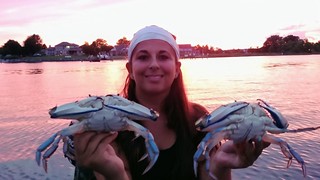
Angelina Watts holds up a pair of nice Miles River crabs caught while trot lining with her dad recently. Photo by Rich Watts
The arrival of cobia continues to be on hold at the moment. There have been a few unconfirmed reports of cobia caught near the Target Ship but most reports have the cobia hung up in lower Virginia waters. This could be due to depressed salinity levels as excessive runoff from May continues to slowly work its way down the bay.
Shoreline fishing for white perch remains an early morning or late evening affair this week due to warm water temperatures in all regions of the bay. Casting small spinnerbaits, spinners or jigs is a fun way to catch some of the larger white perch on light tackle. Casting chartreuse Clouser minnows with a sinking tip fly line is also a great way to have some fly-casting fun. During the day bottom rigs baited with grass shrimp or bloodworms is the best ticket to a catch of white perch. A good hard bottom or oyster reef really ups the odds.
Recreational crabbing continues to improve with the best opportunities in the middle and lower bay. Some of the best catches are coming from the lower bay tidal rivers and creeks. Razor clams tend to outperform other baits and waters shallower than 15 feet seem to offer the best crabbing.
The Deep Creek Lake vacation season is now in full swing and fishermen are contending with heavy boat traffic during most of the day. Many of the fish have shifted to a summer pattern of activity; which means good fishing near points and grass beds in the early morning hours or late in the evening. Anglers continue to drift along in boats and fishing with minnows on a jig head or inline weight for walleyes in sections of the lake such as Beckman’s. Other fishermen are casting surface lures back in the grassy coves toward dark for largemouth bass and pickerel. During the day, flipping soft plastics such as stick worms under docks is the ticket for largemouth bass.
The Upper Potomac is returning to normal flow levels but the water is still reported to be cloudy. Smaller sized smallmouth bass can be seen taking emerging aquatic insects and some of these bass wind up being the prey of much larger smallmouth bass. Dark-colored tubes and swimbaits can be a good lure to entice some of the larger smallmouth which are usually holding deep.
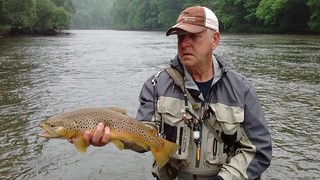
Danny Teets sent in a picture of a beautiful brown trout he recently caught while fly-fishing in the Youghiogheny River Catch-and-Release Trout Fishing Area. Photo courtesy of Danny Teets
Biologist Alan Klotz sent this report about trout waters:
“Trout streams in Western Maryland are fishing remarkably well for this time of the year. Recent high flow events have subsided, and streams are now at fishable flows. Fly-fishing with dry flies such as Stimulators with a nymph such as a Hare’s Ear attached as the dropper fly have been producing well in places like the North Branch Potomac River Catch-and-Return Areas downstream of Jennings Randolph Lake, the Savage River Trophy Trout Fishing Area , and the Youghiogheny River Catch and Return Area. Mornings and evenings are the best time for just fishing dry flies. I have been fishing the Youghiogheny River Catch-and-Return Trout Fishing Area at dusk using a size #12 Elk-Hair Caddis with a yellow body and doing quite well.”
Fishing for warm water species has settled into a typical summer pattern of behavior where largemouth bass move into shallower areas at night to feed and linger in the early morning hours before returning to shady and cool locations. Targeting the shallower areas at dawn with buzzbaits, frogs, lipless crankbaits and poppers are a good tactic. Later on sunken wood, feeder creeks, thick grass over deeper water and shady docks and fallen treetops are great place to fish with stick worms, grubs and various soft plastics. Fish them slow and deliberate since lounging bass tend to be lazy in regard to picking up a bait.
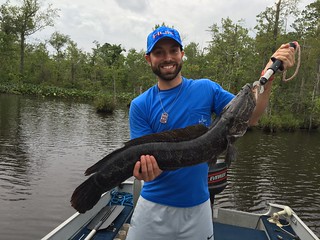
Brian Floyd was fishing with his dad on the Chicamacomico River when he caught this whopper of a snakehead. Photo by Herb Floyd
Crappie and bluegills can often be found close to deep sunken wood such as fallen tree tops or logs. Small minnows on a 1/32 ounce jig head are hard to beat or a simple bobber rig with a minnow or worm will often do the trick. Fishing for channel catfish is best toward the evening hours and into the night in channel areas and deeper holes in the tidal rivers. Cut bait from gizzard shad or something similar such as menhaden is a good choice as is chicken liver or any of the commercial catfish dough baits. In the tidal Potomac, Patuxent and Nanticoke rivers blue catfish are abundant and will readily take fresh cut baits.
The tidal rivers and creeks of the western and eastern sides of the Chesapeake Bay hold good populations of largemouth bass. Invasive species such as the blue catfish and northern snakehead are expanding their range into every tidal river and creek of the Chesapeake as well. Reports come in every week of sightings of parent snakeheads protecting clusters of fry this time of the year in new locations. The northern snakeheads will often be encountered when fishing with topwater lures and the buzzbait is a real snakehead killer. The sound and disturbance of a buzzbait churning across the surface of the water seems to drive them crazy and they strike violently.
It was a breezy weekend in Ocean City and offshore boats sat at the dock while rough surf conditions kept lifeguards busy at the beaches. Fishing for kingfish in the surf has slacked off and the fish are few and far between this week. There are some flounder, blowfish and small bluefish being caught though. Inshore sharks can provide some hefty catch-and-release action in the evening hours on large cut baits and stout tackle.
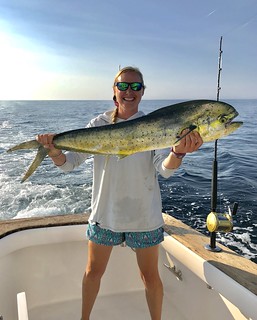
Jane Millman managed to get offshore with some friends before the weekend blow and is all smiles with this nice dolphin she caught.Photo by Kevin Thomas
At the inlet sheepshead and tautog are being caught at the South Jetty and a few are being caught at the North Jetty and Route 50 Bridge. Flounder are being caught in the inlet and back bay channels despite some cloudy water kicked up by recent winds.
Outside the inlet the trolling action for a mix of king and Spanish mackerel with a few large bluefish mixed in continues at the nearshore shoal areas. Clark spoons behind an inline weight with some wire has been the ticket to this unusual event, make sure to not miss it. The lumps farther offshore are holding large bluefish, bonito, dolphin and skipjacks.
Sea bass fishing has been good at the offshore wreck and reef sites and the largest sea bass are coming from the deeper offshore waters. These deeper areas near the canyons also hold blueline tilefish. Flounder are becoming a larger part of the mix at the inshore wreck and reef sites.
There will be a good ground swell this week from the storm off Cape Hatteras but if the winds stay calm, there should be some wonderful fishing at the canyons. There is a large warm water eddy that has moved into the region this week. One can only imagine how good the offshore fishing will be in that region for a mix of blue marlin, white marlin, dolphin fish and yellowfin tuna.
Be sure to do what you have to do to get out there later on this week.
“A fish that gets away always carries some insoluble secret with him.” — Roderick Haig-Brown
 ABOUT THE AUTHOR Keith Lockwood has been writing the Fishing Report since 2003 and has had a long career as a fisheries research biologist since 1973. Over the course of his career he has studied estuarine fishery populations, ocean species, and over a decade long study of bioaccumulation of chemicals in aquatic species in New Jersey. Upon moving to Oxford on the eastern shore of Maryland; research endeavors focused on a variety of catch-and-release studies as well as other fisheries related research at the Cooperative Oxford Laboratory. Education and outreach to the fishing public has always been an important component to the mission of these studies. Keith is an avid outdoorsman enjoying hunting, fishing, bird dogs, family and life on the eastern shore of Maryland.
ABOUT THE AUTHOR Keith Lockwood has been writing the Fishing Report since 2003 and has had a long career as a fisheries research biologist since 1973. Over the course of his career he has studied estuarine fishery populations, ocean species, and over a decade long study of bioaccumulation of chemicals in aquatic species in New Jersey. Upon moving to Oxford on the eastern shore of Maryland; research endeavors focused on a variety of catch-and-release studies as well as other fisheries related research at the Cooperative Oxford Laboratory. Education and outreach to the fishing public has always been an important component to the mission of these studies. Keith is an avid outdoorsman enjoying hunting, fishing, bird dogs, family and life on the eastern shore of Maryland.

